Cocker Spaniels – one of those dog breeds with the sweetest hairstyle! Oh, I could run my fingers through their curls all day long! I’m sure there are plenty of Cocker Spaniel fans out there who would agree with me.
They’re truly remarkable dogs, and I completely understand why someone would adopt a Cocker.
What else I can understand is your cry for help.
Getting a Cocker doesn’t only mean taking it out for walks. You’ll need a full guide on raising Cockers, as well as feeding them. Yup, feeding, because it’s a lesson of its own. Luckily, you’ll have PupVine’s Cocker Spaniel feeding chart to help!
I went on and beyond to find you the ultimate guide on feeding dogs of this breed. And, let me tell you something – it wasn’t easy since no dog is the same. Some eat more, some eat less. Some prefer kibble, others prefer wet food.
Today, we’ll go through everything in depth. As a future Cocker Spaniel owner, you’ll find out how much food a growing puppy needs. You’ll learn about an adult Cocker’s eating habits, which dog food brand is the best, whether to feed your dog raw food, etc.
Simply put – you will learn about everything from puppy food and first meals, to adult food and controlling their weight.
Sit back and let me do the talking. You’ll need this before your Cocker arrives home!
Puppy Feeding: Cocker Spaniel Feeding Chart By Months
| Age | Amount of food |
|---|---|
| 2 weeks | mommy’s milk or doggy formula |
| 4 weeks | 1-2 cups, 3-4 meals daily |
| 6 weeks | 2 cups, 3-4 meals daily |
| 8 weeks | 2-3 cups, 4 meals daily |
| 10 weeks | 3-4 cups, 4 meals daily |
| 12 weeks | 4-5 cups, 3 meals daily |
Cockers At Two Weeks
Cocker Spaniels at two weeks are still just babies. The only source of proteins at this stage is their mommy’s milk.
If, by any chance, the mom’s not able to feed her little ones, the puppies should be fed specially designed puppy formula. Cow’s milk is not an option because it’s nowhere similar to dog’s milk.
Cockers At Four Weeks
At this stage, puppies will finally switch from mommy’s milk to their first kibble bits.
However, this transition is gradual, and it should not happen too fast. Let the puppy accept the new texture and flavor first!
I want to suggest that you soften up your puppy’s kibble with warm water. The first few times should be a bit mushy, but reduce the amount of water as your puppy grows. This is simply to help him get used to the fact of eating something solid.
Chewing as a way of exercising the strength of the jaw comes soon.
Cockers At Six Weeks
Cocker Spaniel puppies at this stage should be completely weaned from their mommy’s milk.
They’re now active puppies that love to explore, and they need the energy to do it. At six weeks, make sure your Cocker puppy has four meals and two cups of food daily.
Cockers At Eight, 10, And 12 Weeks
Many dog breeders are ready to list their Cocker puppies up for adoption at this stage. Some are ready at eight weeks, some at 12. It all depends on the breeder.
What’s important is that the puppy is now flying solo and eating kibble without any assistance.
As you can see from the chart above, daily meal intake will drop down to three at 12 weeks of age.
Another transition will happen once the puppy is considered an adult. Up until then, puppies should have around three meals a day and four to five cups of dog food.
How Much Do Cocker Spaniels Eat?
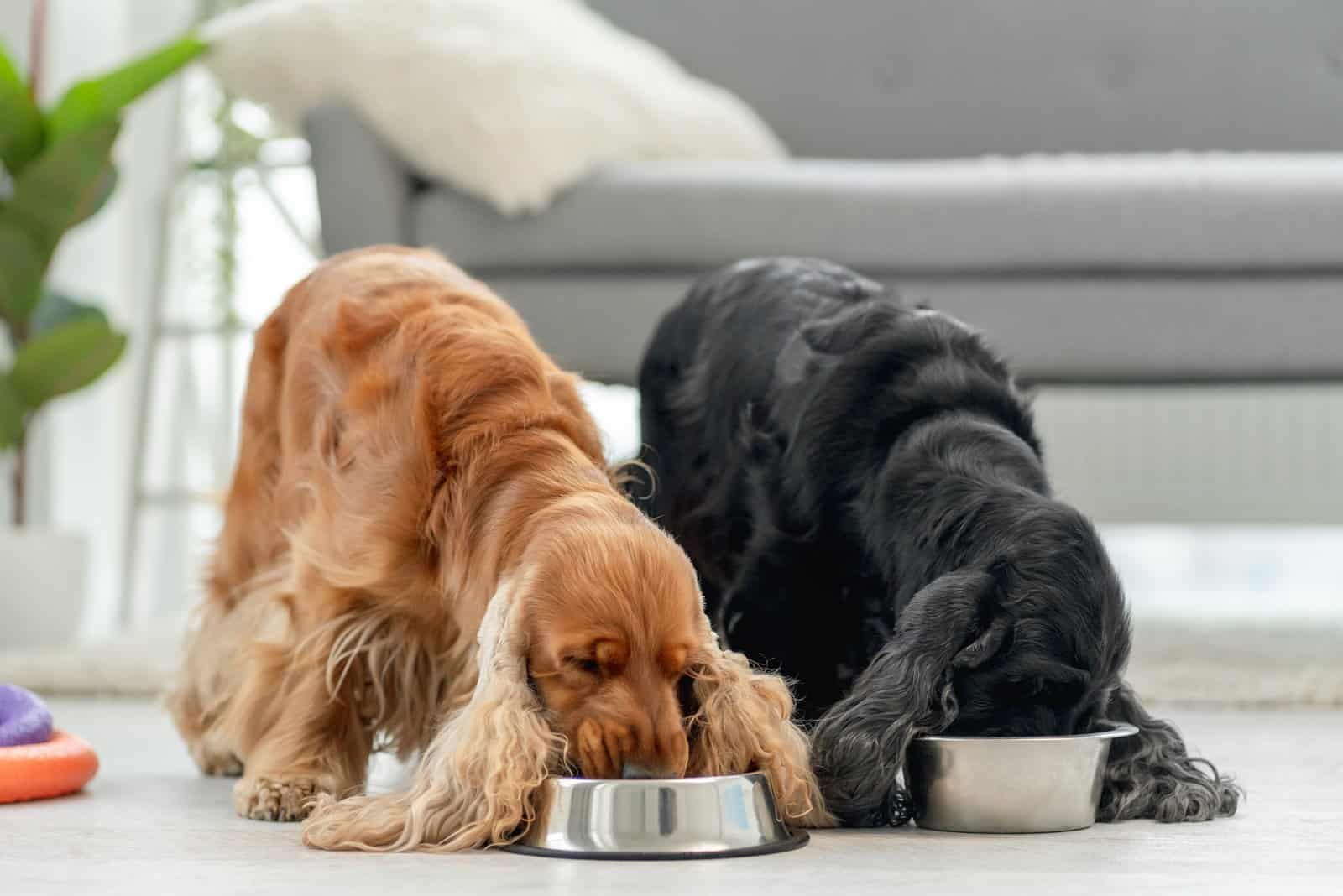
Cocker Spaniels are small-breed dogs, leaning to medium, meaning they won’t need as much food as Dobermans, for example.
The amount of food a Cocker needs will depend on the gender, as well as the life stage the dog is at. Puppies need more meals and more kibble. Adult dogs, or Cockers after the age of 12 months, will need less food.
It’s as simple as that!
Usually, grown-up Cockers will need four to five cups of food every day. This means real, high-quality meals, and no dog treats all the time!
Weekly Growth For Cocker Spaniels
We don’t have to show you a Cocker’s weekly growth by using a chart. It’s pretty simple, even throughout the weeks.
A healthy Cocker Spaniel puppy should grow 1/2 pound each week. This is absolutely normal and sufficient for dogs of this size. Cockers are classified as small to medium dogs. They won’t grow up as fast as some other dog breeds like Labradors or Golden Retrievers.
However, just because it’s recommended for Cockers to grow 1/2 pound weekly doesn’t mean that every puppy will follow the same pattern.
Numerous reasons are hiding behind slower growth, or even faster growth.
The activity level of your puppy, the kibble brand you’re using, genetics, conditions under which the puppy is being raised… they all play a significant role in its weekly growth.
If we exclude all the negative factors, including poor genetics, we’d have a healthy, growing Cocker Spaniel puppy.
How Much Should I Feed My Cocker Spaniel Puppy?
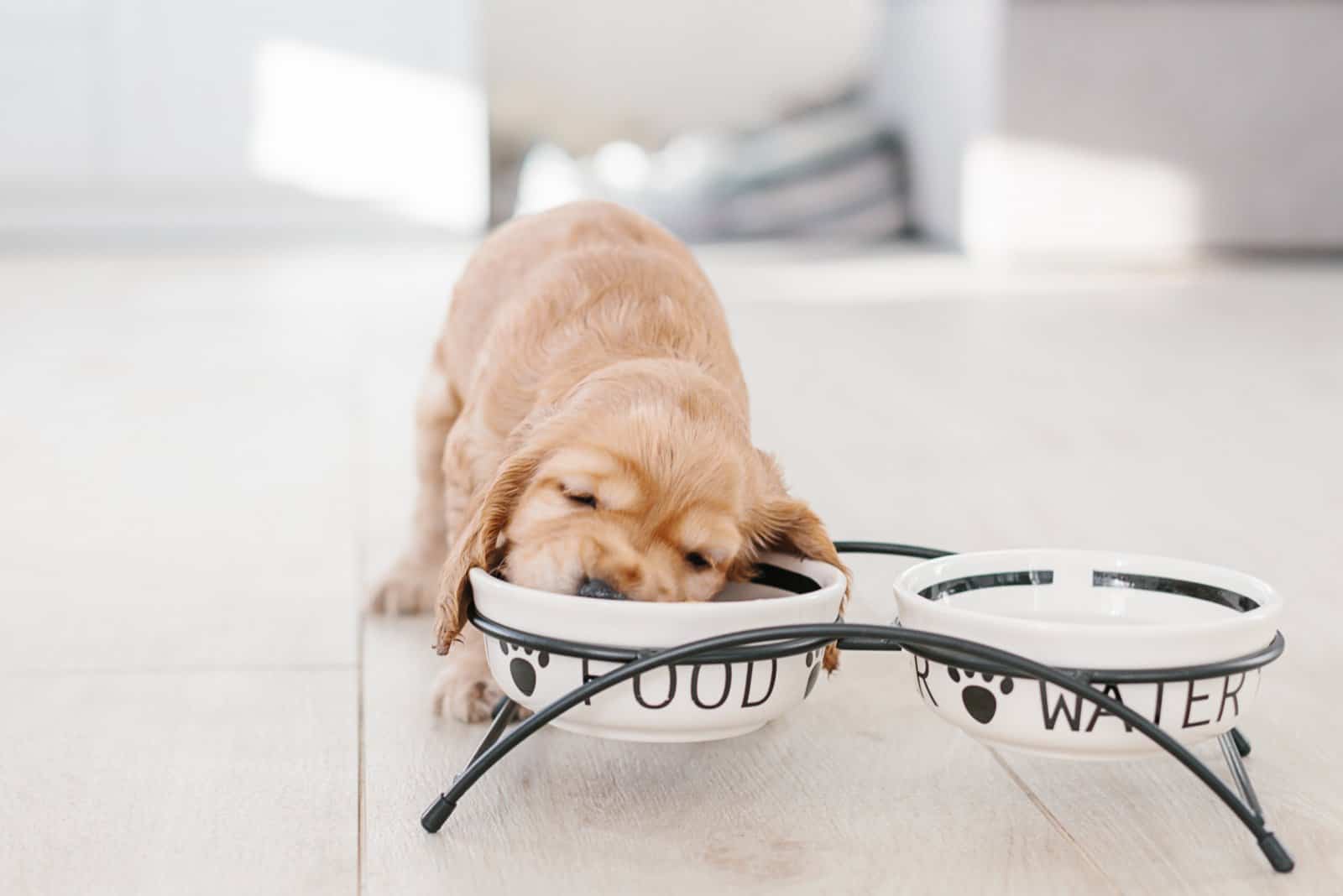
Pretty much every bag of pet food comes with instructions on the back saying how many cups of food to feed your puppy. Each bag will have enough cups to last you a while, so you don’t have to worry about running out in the middle of a meal.
Specially-designed puppy food is usually made for puppies of one month to three months. Of course, three-month-old Cocker puppies will eat more kibble than one-month-old Cocker puppies. This is simply because the little ones feast on their mommy’s milk.
Puppies of this age and medium size should have four meals a day. The meals should be separated, so there’s plenty of time in between them. This prevents obesity, and helps you get better control of the amount of food.
Cocker Spaniel puppies should have two to three cups of kibble every day. Some might need more since they’re bigger, so stick with three cups. Between male vs female Cockers, girls eat less, so they’re more likely to only need two cups a day.
To help you figure out exactly how many calories your Cocker needs on a daily basis, here’s a simple calculation.
You should calculate your dog’s RER. But, what’s RER?
RER means Resting Energy Requirements. In other words, the amount of energy your dog needs while doing… nothing!
You should multiply your dog’s weight with 3/4 multiplied by 70.
So, if your Cocker Spaniel puppy weighs 10 pounds, that should be:
70 X 10kgs ¾ = 400 calories
This calculation is on a daily basis. Normally, you will find out how many calories one cup of your chosen dog food contains, and then try to reach the recommended calorie intake during the day.
How Often Do Cocker Spaniels Need To Eat?
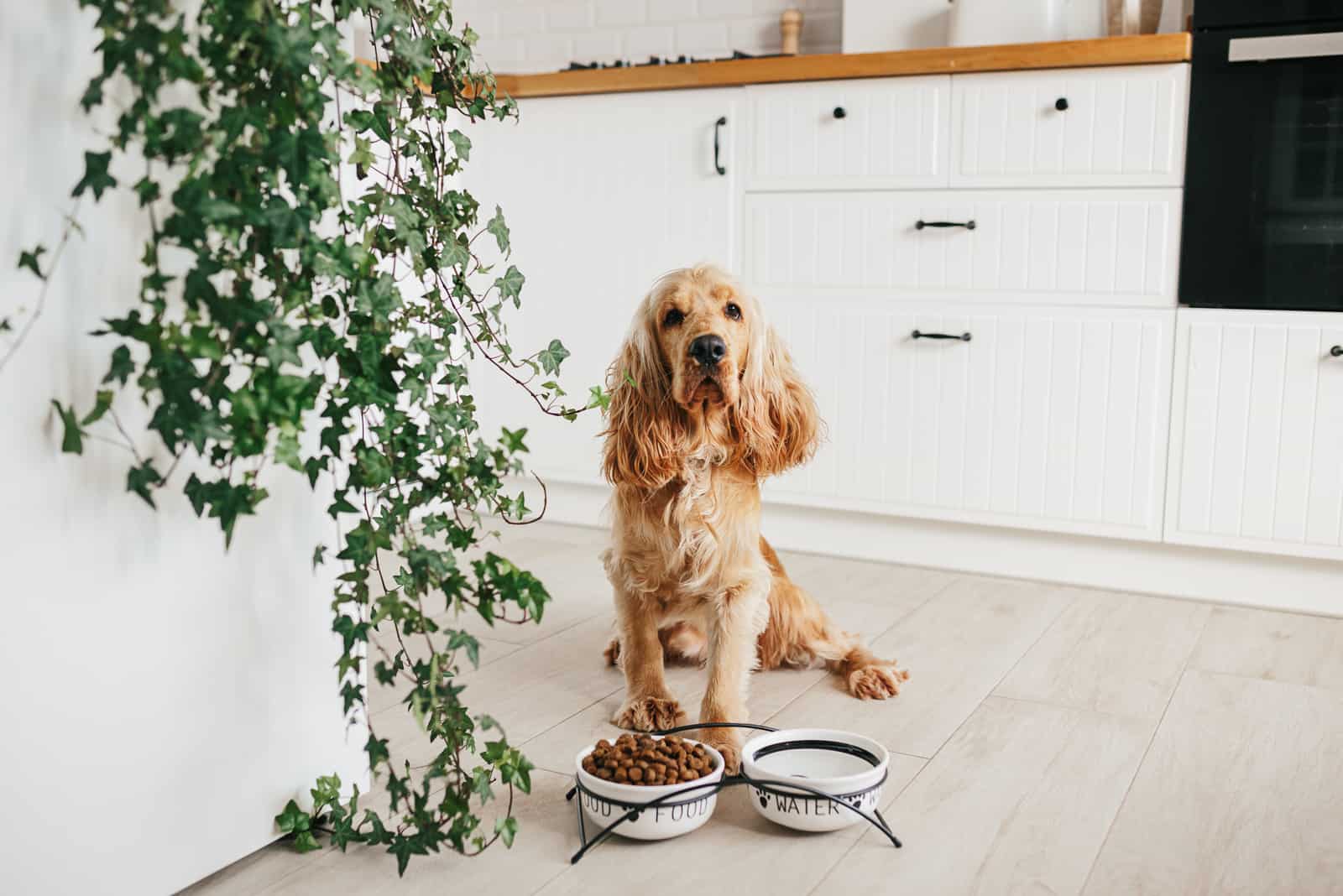
The number of meals during the day depends on the age of your Cocker Spaniel. There’s no way that Cocker Spaniel puppies and adults will eat the same amount of dog food. In fact, they don’t even eat the same food in terms of quality and content.
Since we’ve already discussed how much food Cocker Spaniel puppies take in on a daily basis, we’ll now focus on feeding adult Cockers.
As most dog breeds, Cocker Spaniels will turn from puppies into adults somewhere around their first birthday. This is the time when major changes stop and your dog doesn’t grow that much anymore.
His many meals are now being reduced to only two a day. Basically, your dog should have breakfast and dinner. The recommended daily food intake should be divided between these two meals, and it should not be exceeded.
I recommend you set your dog’s meals at the same time every day; for example, at 8 AM and 7 PM. Some dogs like to eat the moment they open their eyes in the morning, so be there when they get up.
Spacing out meals should be a must in order to prevent obesity and unhealthy habits.
If you believe your dog needs a meal in between the mentioned two, you’re clearly doing something wrong. Dogs need their minds busy during the day, not their mouths! An occasional treat will be fine, especially if you’re practicing obedience commands or fun tricks.
Do Cocker Spaniels Need To Eat Wet Food?
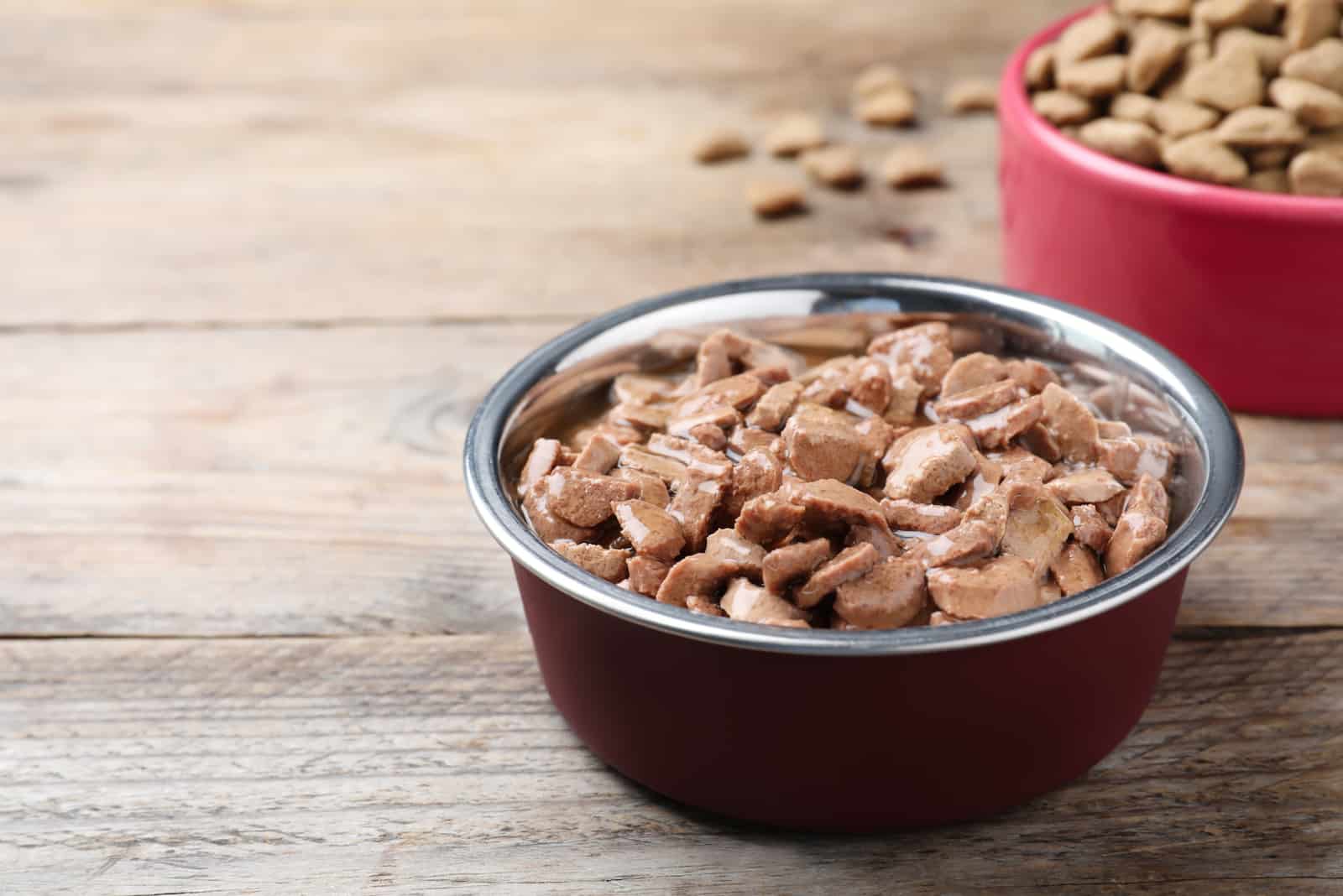
There’s often a debate as to whether your dog should eat wet food or kibble / dry food. Frankly, there are many pros and cons for both feeding options, and we’ll go through them all soon.
What I want you to realize is that what you feed your dog is only your business. You can choose kibble, or wet food, or even a combination of both! Hey, you can even choose a raw diet. The most important thing is to make sure you understand what your dog needs.
Over the years, in my practice, I’ve seen pups struggling with normalizing their stools because they ate kibble or canned food that didn’t suit their digestion.
Coming up, you’ll read about the pros and cons of both types of food.
Pros And Cons Of Kibble And Wet Food
The biggest pro of a wet diet is its texture. A dog’s teeth can be quite sensitive. Kibble is dry, and sometimes rough. It can hurt your dog’s gums. Also, dry kibble can cause constipation if not enough water is taken in on a daily basis.
Wet dog food is rich in fibers, proteins, and fats. Dogs seem to have no problem consuming it because it’s so soft. There’s nothing that can hurt the gums or get stuck between the teeth.
What many people don’t understand is that kibble is designed for large dog breeds since it stores more energy value. Wet food is usually served to small pooches because they don’t need that much energy throughout the day.
When you look at both textures in terms of pricing, kibble is definitely the cheaper option. Also, it won’t get spoiled that easily. Wet food or dog cans are too pricey, and you will need lots of them to keep a Cocker Spaniel full.
But, the final decision is up to you. If your budget can take it, feel free to feed your dog the most expensive food on the market.
How Do I Know If My Cocker Spaniel Is Overweight?
Actually, it’s quite simple to spot an overweight Cocker Spaniel.
You’ll notice your Cocker Spaniel looks a bit… rounded!
There won’t be a noticeable abdominal tuck, and that’s the first sign of your dog being overweight. Additional signs can be spotted if you perform a visual test with palpation.
If you look at your dog from above, you should be able to notice its tuck. There will be a slight curve of your dog’s body. However, overweight Cockers don’t have this.
Next, you should be able to feel the dog’s rib cage. Protruding ribs are a sign that your dog needs to put on weight. But, with overweight Cocker Spaniels, their ribs aren’t visible, and you can barely feel them. This means that your dog has extra-stored fat covering his muscles.
Lastly, the easiest way to tell if a Cocker is too chubby is to simply weigh your dog using a scale. In case your dog doesn’t want to cooperate, and runs away from the scale, simply measure yourself first, and then step on it with your dog. The math here is pretty simple.
A Cocker Spaniel of normal weight should follow the ranges of a growth chart for this dog breed. The measurements don’t have to stick blindly to the ranges on the chart, but they should be as close as they can get.
Your adult dog should weigh up to 32 pounds. Anything over this is considered unhealthy and overweight. Anything under 25 pounds for this dog breed is also unhealthy, and such dogs are severely underweight.
What Should I Do If My Cocker Spaniel Is Overweight Or Underweight?
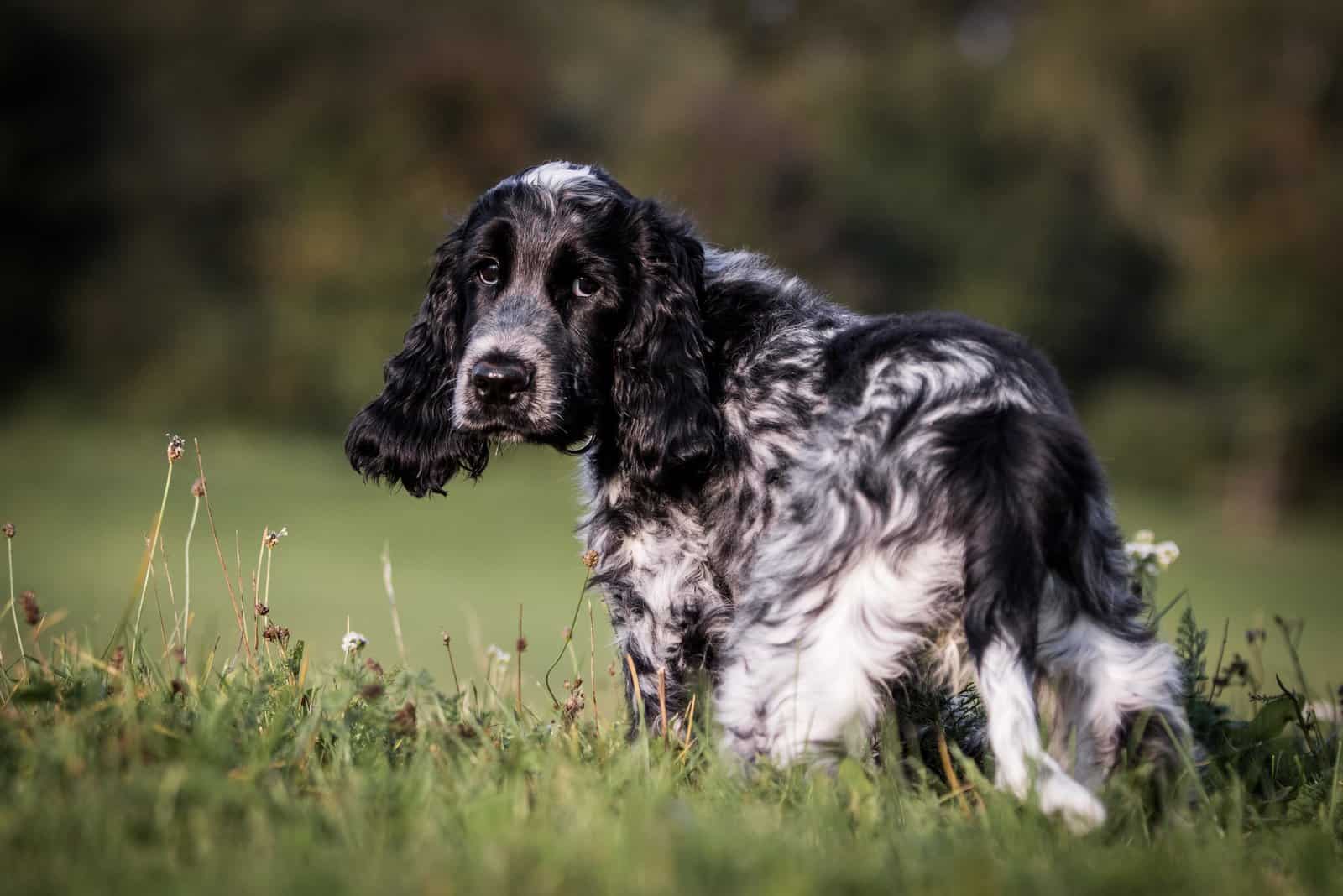
You may think it will be simple to solve these issues, but the truth is pretty far away from that.
How many times have you heard someone complain that it’s hard for them to put on weight, no matter what they eat? Not to mention how many times you have heard people complaining about how hard it is to lose weight!
Well, it’s the same for our canine buddies. Don’t think your Cocker Spaniel will easily lose weight if you cut down his meals.
With controlling obesity, you need to be careful, and don’t do anything on your own. Consult your vet first. Obesity is pretty common with these dogs. It may even run in the pup’s bloodline.
First off, remember what the breeder said about your dog’s parents. If they were battling with weight, your pup will, too. And, the reason for excessive body weight must be found in their hereditary diseases. Dog thyroid problems are often the reason behind weight-related issues.
If the bloodline is clear of obesity, then you must test your dog. As I mentioned, thyroid issues, hormonal imbalance, parasite infections… they all can be a reason for obesity.
Let your vet examine your dog and prescribe a treatment. In case your dog is clear of any health issues causing obesity, it’s time to cut down the food.
Use specially designed dog food that’s usually grain-free and lean, designed to control your dog’s weight. Cut down the treats and replace them with healthy substitutions like broccoli pieces or artichokes.
But, don’t cut down your dog’s meals. Follow the feeding guide on the back of your new dog food. Our pups still need food as energy to function.
As for underweight dogs, besides excluding health issues, all you can do is find some weight-gain treats and switch their kibble to high-quality ones packed with more nutrients.
Nutritional Needs For Cocker Spaniels

Despite being small-sized dogs, Cocker Spaniels still need high-protein food to grow up nicely and develop like all the other dog breeds.
A Cocker Spaniel’s daily need for protein is around 25%. Anything over that would be ideal. Usually, Spaniels take 28% of proteins.
Naturally, growing Cocker Spaniel puppies will need more protein. The amount drops down once the dog is considered an adult because he will stop growing. Senior Cockers also don’t need that much protein.
But, they do need other goodies!
What puppies and seniors share is their great need for calcium. This mineral makes the bones stronger and less prone to breaking. Fragile bones is the signature condition for both little ones and older pups.
Make sure your dog eats dog food with the right amount of calcium throughout its whole life. You can’t just start to give it once your dog enters old age… that’s too late.
Also, boost your senior’s diet with chondroitin and glucosamine. You don’t have to take these as supplements. Many great dog food brands feature them as one of the most frequent components of their recipe.
A balanced diet is the key.
Your Cocker Spaniel’s kibble formula would be ideal if it also features K-9 strains of prebiotics, probiotics, amino acids for healthy skin and coat that keeps shedding moderately, and a sharp brain, along with vitamins and minerals from fruits and vegetables.
Good carbohydrates for energy are also welcome, but stick to ingredients such as brown rice or sweet potato.
Can Cocker Spaniels Have A Raw Food Diet?
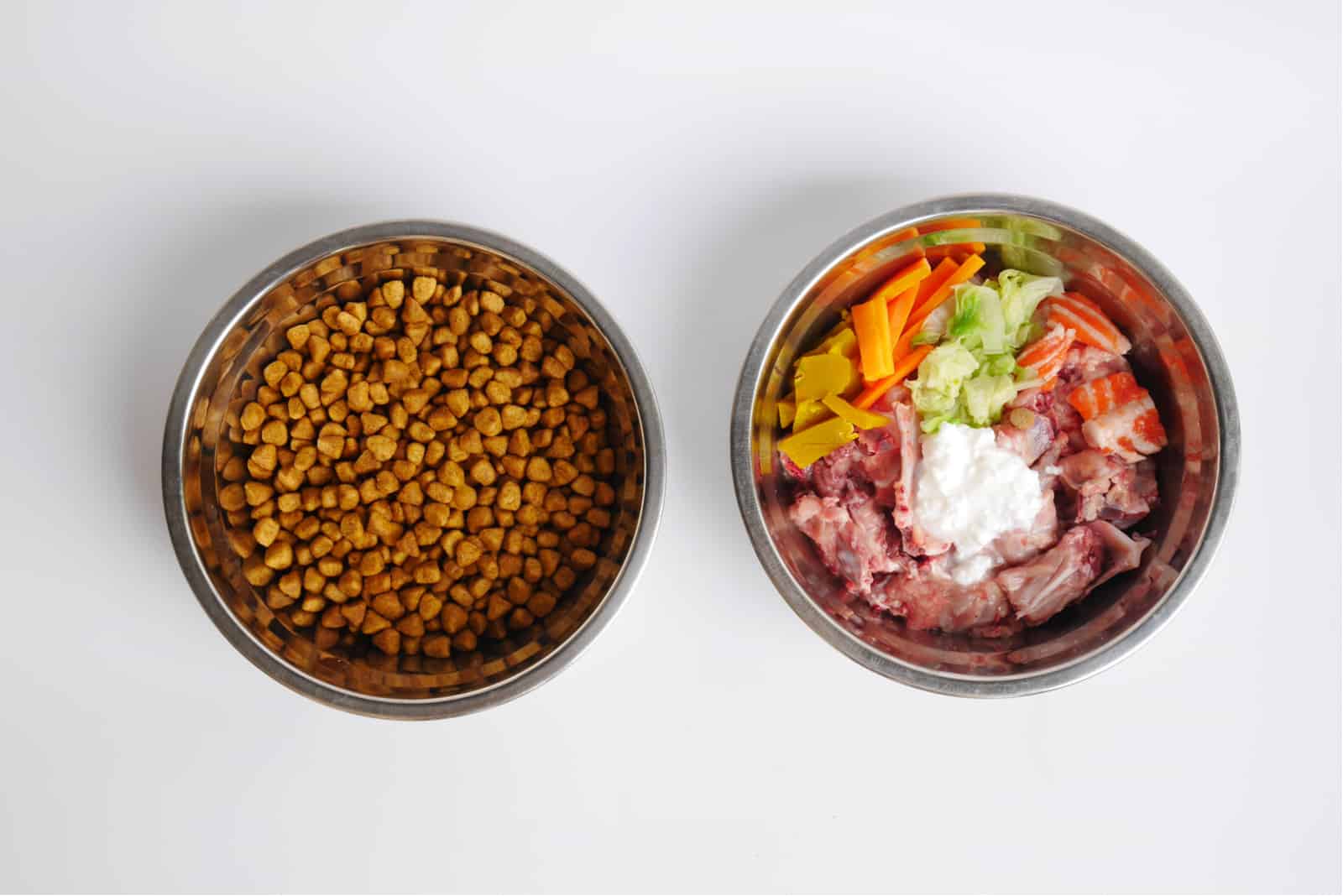
If you’re a first-time owner and you still need to learn a lot about dogs, then you’ll be surprised with how many dog lovers prefer raw-food diets. It has become sort of a movement lately, and I’m pretty excited about it.
Let’s face it: dry dog kibble has become a thing over the past fifty years. What did our pups eat before? Well, food scraps usually, but there’s no way that you should feed your dog blue cheese off your plate, or spicy jalapenos!
Back in the day, reliable dog owners used to feed their Cockers raw food. Since Cocker Spaniels are hunting dogs, getting only premium animal protein wasn’t hard for them. They were used to consuming wild ducks, rabbits, and other small-prey animals.
It was consumerism and convenience that made us all switch from a raw diet to kibble. But, kibble pretty much… blows. It’s hard on teeth and gums (despite how much good it does to jaw development), it has a limited amount of flavor, and sometimes it lacks nutrients.
Feeding your dog raw food is a much better option. Dogs eat meat, and that’s a fact. Sure, our pups will like occasional peppers thrown in their doggy food bowl, but meat dominates.
For a Cocker’s digestive health, I suggest you try this raw diet. It usually focuses on poultry and fish with this dog breed. Red meat might be too hard on their belly. By feeding your dog a raw diet, you will avoid any fillers, additives, colorings, or preservatives. You’ll know what you’re feeding your dog, and you’ll know it’s of good quality!
A raw diet has proven to be beneficial in many ways from a shiny and healthy dog coat, to a stronger immune system! You can start feeding your puppy raw even from the early months of its age, just after they’ve been weaned from mommy.
In the following section, I will give you three quick raw-diet meal ideas for your Cocker Spaniel.
Top Three Raw Food Diet Recipes For Cocker Spaniels
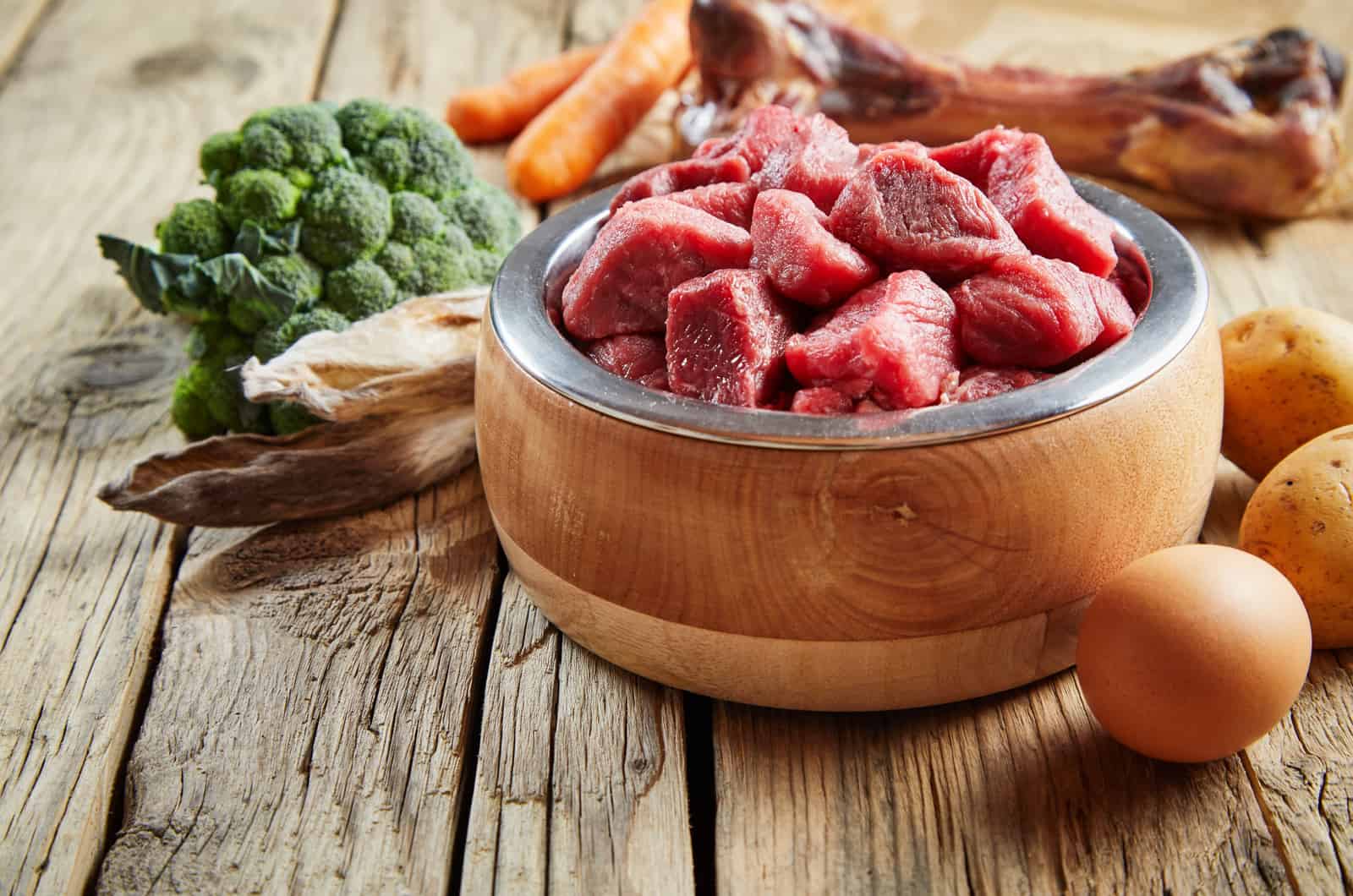
Lately, I’ve seen many brands coming up with their own raw diet meals ready for you to come and buy them. I support the raw food diet industry, but why buy when you can DIY. Raw doggy meals can easily come out of your kitchen if you only have a couple of recipe ideas.
Raw Puppy Patties
You can also call these puppy burgers, but you don’t have to grill them. Just mix all ground ingredients together and shape them into patties.
For this recipe, you will need some ground beef and some chicken liver. Make sure the ratio goes in favor of ground beef. Chicken liver is there to support the protein count. Usually, meals based only on chicken meat aren’t the happiest choice for Cockers.
Then, add some nicely chopped apples, spinach, carrots, or blueberries. Add some yogurt to create a mixture that you can shape. Olive oil is a nice touch, as well as flaxseeds, and they help with the dog’s digestion.
The best part of this is that you can make as much as you want and freeze everything your dog doesn’t eat.
Also, since there aren’t any bones in this recipe, puppy patties are suitable for all life stages.
A Turkey Feast
With this recipe, your pup can have Thanksgiving in July!
This meal idea contains almost the whole turkey. It’s a good source of protein for Cockers.
The recipe requires boneless turkey thighs, some turkey necks, the liver, and the gizzard. Add chopped lettuce and zucchini and mix it all together well. These can also be shaped as patties, or even little balls.
It really doesn’t matter whether your dog cleans up the bowl or not. But, trust me – that bowl will be sparkling clean!
A Fishy Twist
Sea fish like herring is very rich in protein and omega fatty acids. I love incorporating it in my dog’s meals whenever I get the chance.
For this recipe, you’ll need the fish / chicken ratio to be in favor of fish. Then, add some ground chicken bones, chicken liver, an egg or two, some greens like broccoli, and a source of fiber, i.e., chickpeas.
This is another meal your Cocker Spaniel will devour!
Top Three Best Food Brands For Your Cocker Spaniel
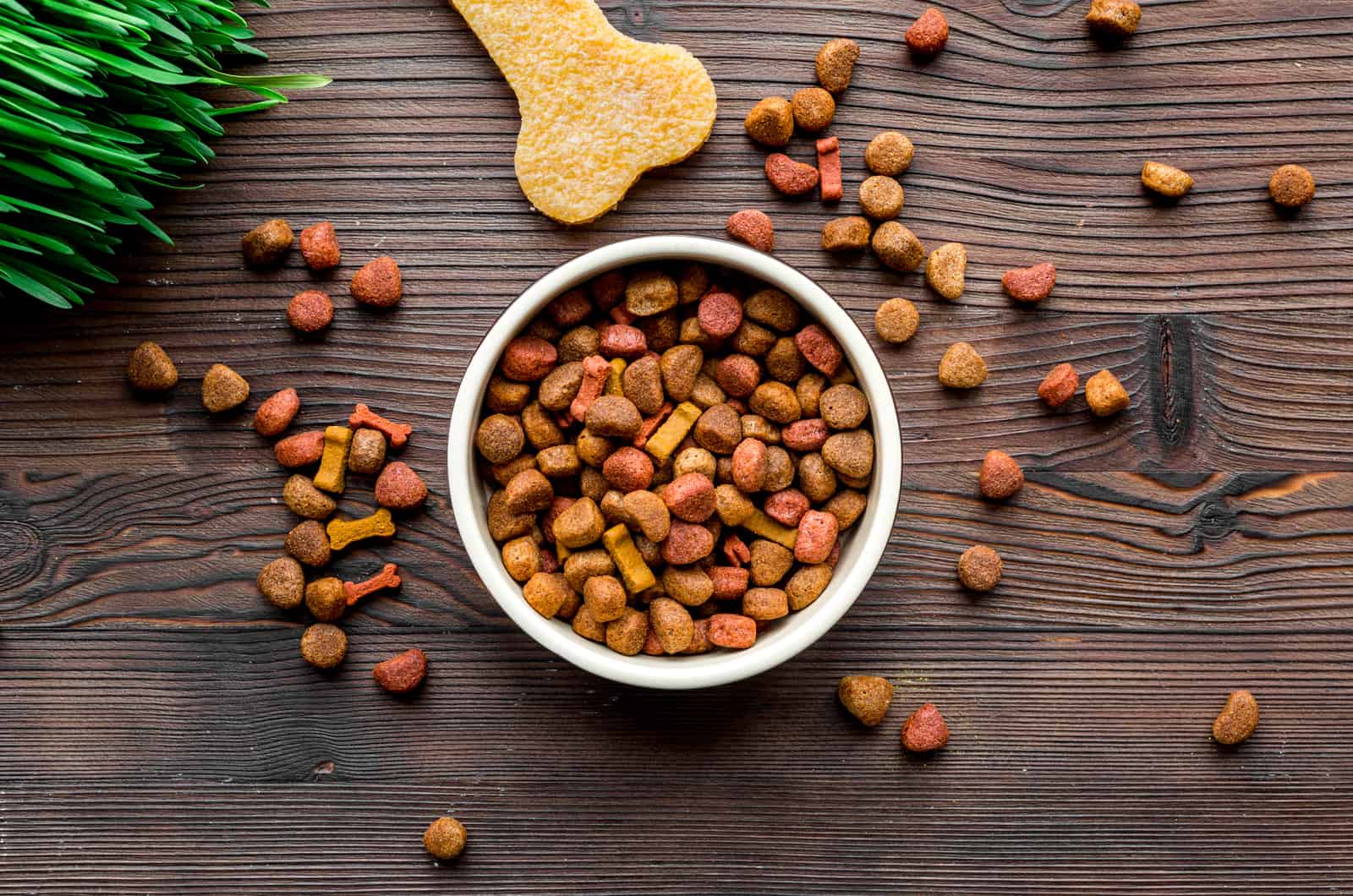
Dry dog food brands can be found from A to Z. There’s a brand for each alphabet letter! But, that doesn’t mean they’re all good for your pup’s digestive system.
I know you’ve heard of brands such as Royal Canin or Purina. They’re the brands you can easily find in supermarkets.
But, I would want more for my Cocker Spaniel.
Instead of running to your local supermarket, maybe try exploring online. You’ll be surprised at how many pawsome dog food brands are being sold!
My personal favorites include Blue Buffalo, Taste Of The Wild, and Merrick dog food brands. They’re all fully focused on proteins and bringing only the highest quality of ingredients.
I’m sure at least one of them will have a formula that will fit your Cocker Spaniel puppy, adult, or senior dog.
DISCLAIMER: I’m not saying Royal Canin and Purina are terrible brands. I’m pawsitive there will be dogs that love them. I just prefer a more natural approach to a dog’s diet, and that’s why I choose the brands from above.
Should Cocker Spaniels Be Free Fed?
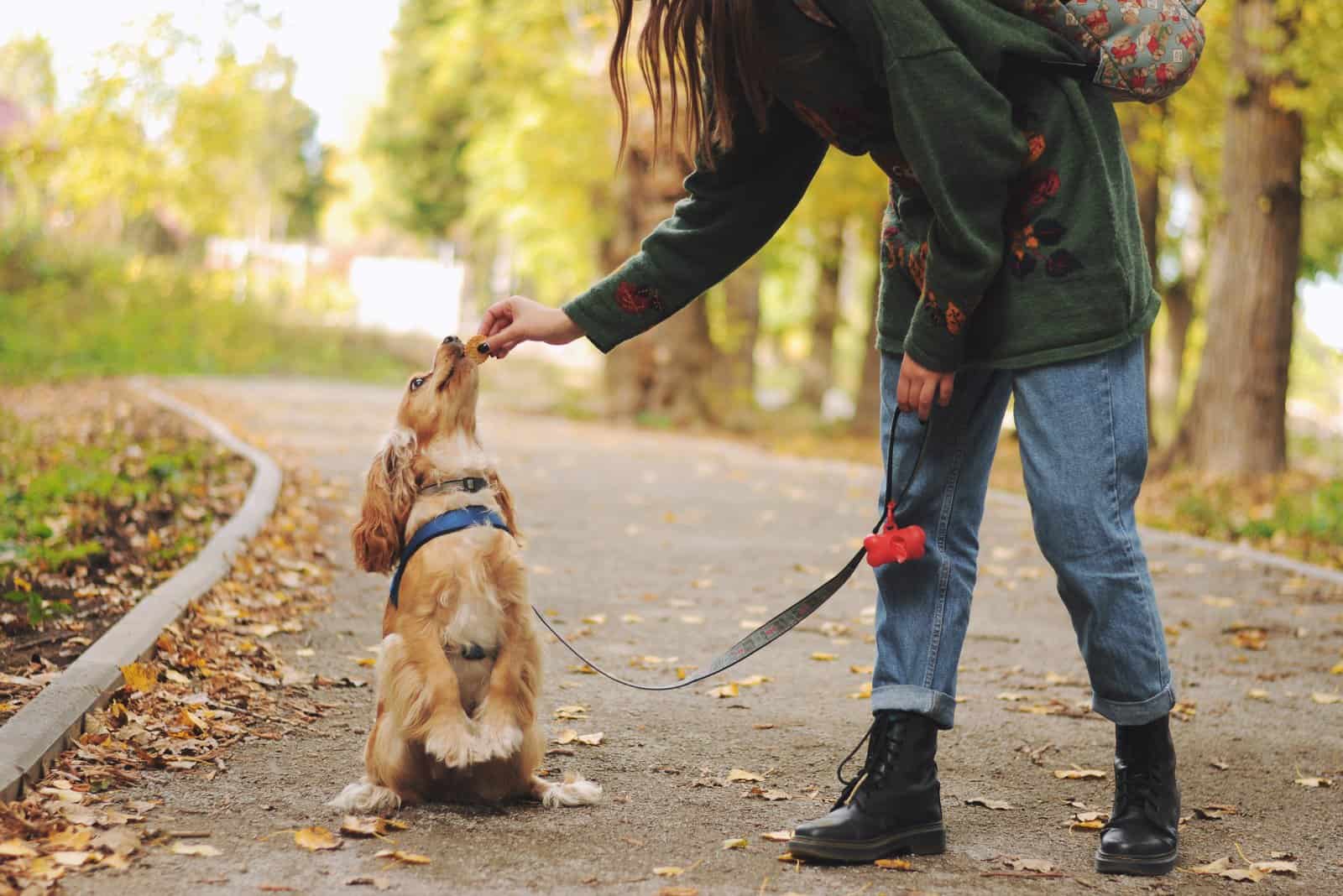
I do not recommend having your Cocker Spaniel free fed. In fact, I don’t recommend this practice with any dog breed, especially not with those that are prone to obesity.
Overeating leads to numerous health problems, and obesity is just the tip of the iceberg.
Imagine the situation – you got your dog a new feeder that dispenses kibble everytime the bowl is empty. Or, you simply tend to fill up the bowl once you see it’s half empty. That’s wrong.
Serving your dog extra doses of kibble so he has something to eat while you’re gone is also wrong.
What you’re doing is enforcing bad eating habits. This way, you’re letting your dog know it’s okay to eat all the time, and that it’s wrong to feel hunger at any given moment.
Overfeeding and obesity go hand in hand. You won’t do much damage if you let your dog free feed for one day. But, you’re risking it becoming a terrible habit.
Cocker Spaniels are relatively small dogs. If you let them become obese, that will make terrible damage to their mobility, hips, joints, bones, as well as their entire cardiovascular system.
Instead of free feeding, opt for a slow-feeder bowl that will make your dog work harder for the food instead of just inhaling it like a vacuum cleaner.
What Do You Do If My Cocker Spaniel Refuses To Eat?
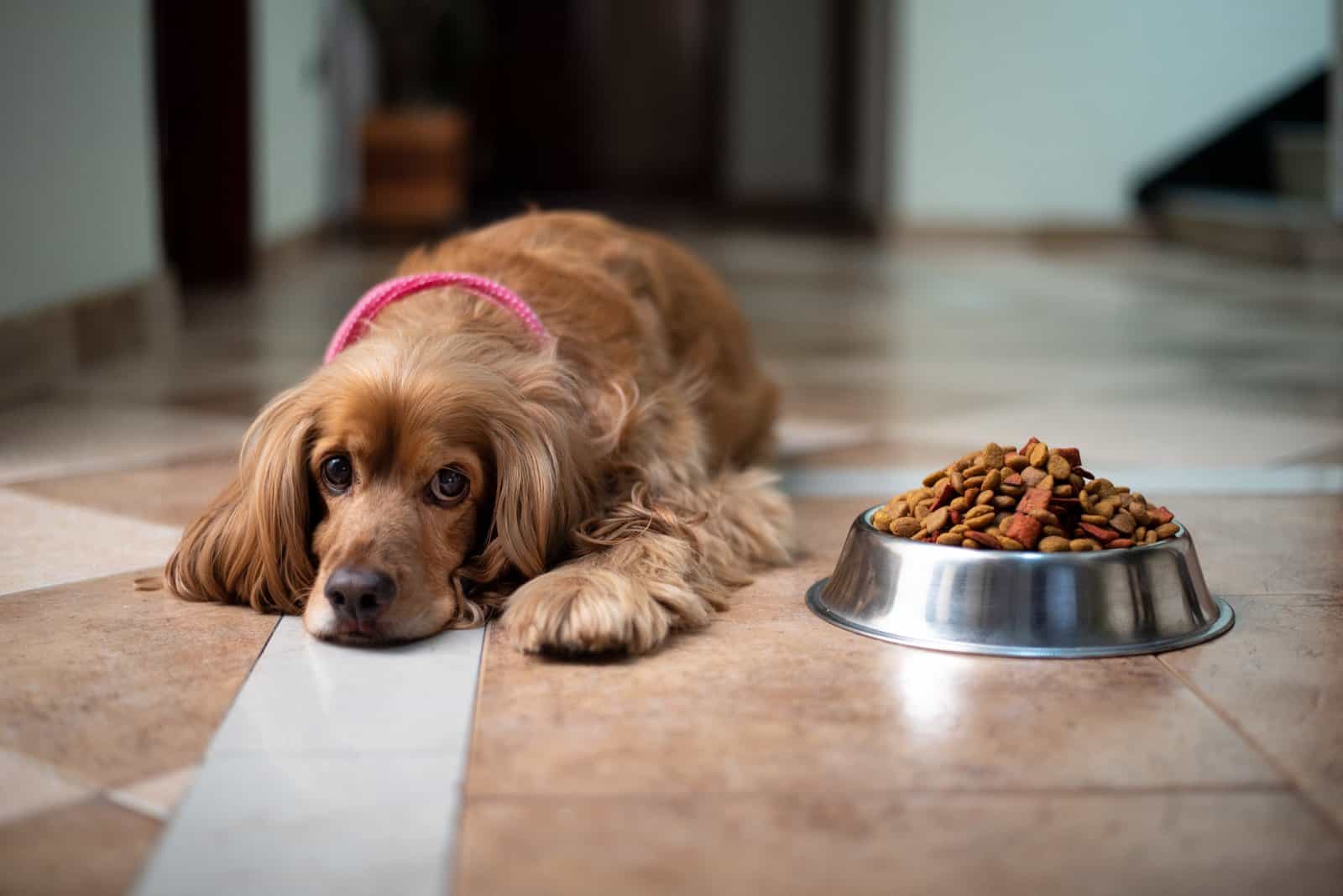
It’s not unusual for a dog to refuse a meal from time to time. There are many reasons behind such behavior.
Problems occur when your dog continuously refuses to eat. What do you do then? Should you force your dog to eat or should you not?
Let’s be honest – even we humans sometimes feel a lack of appetite. Maybe it’s because we had a rich, previous meal. Maybe it’s because we’re thirsty at the moment or simply too tired to eat. This can happen to dogs, too, especially after exercising.
Offer your pooch food, and if he refuses it, leave it there and watch over your dog in order to spot potential behavior problems and symptoms of health conditions.
This little food break shouldn’t last for too long. If you see the obvious signs of refusing a meal, accompanied by depressive behavior or acting restless, then you should see your vet.
Dogs sometimes experience food allergies or internal conditions that we’re not aware of. But, your vet will be once he gets examined.
The bottom line is: don’t push it if you believe your dog is completely healthy. Give him some time. Sometimes, that’s all it takes.
To Sum Up…
Now that you have this Cocker Spaniel feeding chart, you will know how to feed your new puppy, and how much kibble dogs actually need.
No matter which brand you choose, make sure it has plenty of protein for your pup, as well as vitamins, minerals, and other nutrients. Dogs need food to grow, not just to satisfy their hunger. So, don’t reach for treats. Make every meal healthy!
There’s nothing more important than keeping your Cocker healthy and in the right weight range.
Read Next: Merlin The Merle Cocker Spaniel













